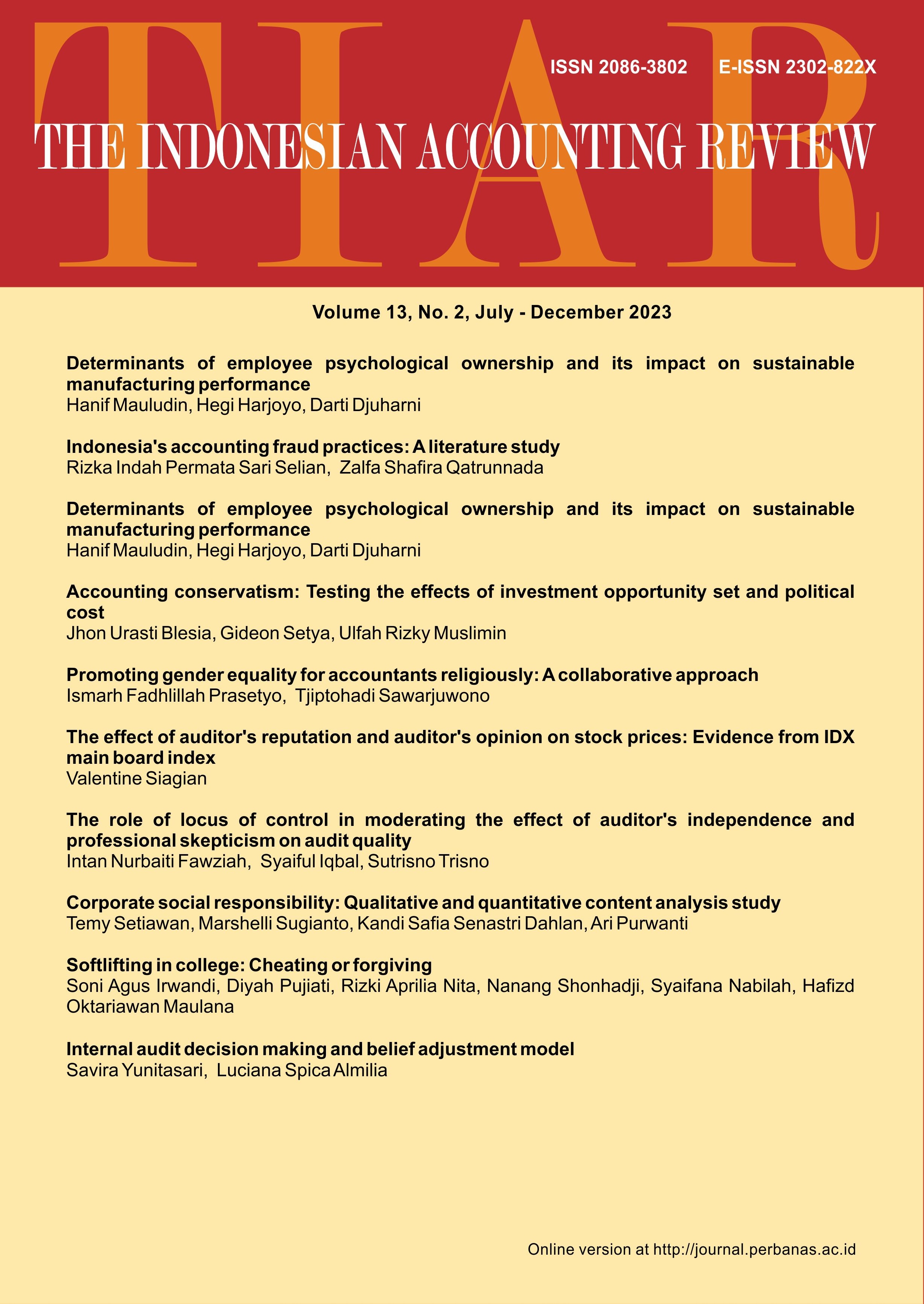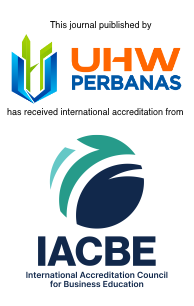Indonesia’s Accounting Fraud Practices: A Literature Study
DOI:
https://doi.org/10.14414/tiar.v13i2.3403Keywords:
Fraud triangle, Fraud diamond, Fraud pentagon, Ffraud hexagon, Accounting fraudAbstract
This study aims to review a number of theoretical frameworks regarding the reasons why someone commits fraud by involving the fraud triangle theory, the fraud diamond theory, the fraud pentagon theory, and the fraud hexagon theory. This research is a qualitative research with a literature study approach. The data used in this study is secondary data derived from articles with the topic of “fraud†in Indonesia for the 2015-2022 research year period. The results of this study indicate that the factors of pressure, opportunity and rationalization have an important role in encouraging someone to commit fraud. Meanwhile, the factors of capability, arrogance, and collusion have not been proven to play a role in encouraging someone to commit fraud. This study is expected to contribute to the accounting literature and can be used in the public sector and organizations. The practical implication of this study is that the public sector and organizations will have a better understanding of the root causes of rampant fraud.
References
ACFE. (2022). Occupational Fraud 2022: A Report to the Nations.
Akbar, D. A., Africano2, F., & Isrodinata, R. (2021). Can Fraud Diamond Affect Fraud Financial Statement in Sharia Commercial Banks? Jurnal Reviu Akuntansi Dan Keuangan, 11(1), 40–57.
Apriliana, S., & Agustina, L. (2017). The Analysis of Fraudulent Financial Reporting Determinant through Fraud Pentagon Approach. JDA Jurnal Dinamika Akuntansi, 9(2), 154–165. https://doi.org/10.15294/jda.v9i2.4036
Arfiyadi, & Anisykurlillah, I. (2016). The Detection of Fraudulent Financial Statement with Fraud Di-amond Analysis. Accounting Analysis Journal, 5(3), 173–181.
Cressey, D. (1953). Other People’s Money, dalam: “The Internal Auditor as Fraud Buster. Manage-rial Auditing Journal. MCB University Press.
Fitri, F. A., Syukur, M., & Justisa, G. (2019). Do The Fraud Triangle Components Motivate Fraud in Indonesia? Australasian Accounting, Business and Finance Journa, 13(4), 63–72.
Hidajat, T. (2020). Rural Banks Fraud: A Story from Indonesia. Journal of Financial Crime, 27(3), 933–934.
Horwarth, C. (2011). The Mind Behind the Fraud-sters Crime: Key Behavioral and Environmental Element, USA: Horwarth International.
Inayanti, S. N., & Sukirman. (2016). The Effect of Factors in Fraud Diamond Perspective on Fraudulent Financial Reporting. Accounting Analysis Journal, 5(3), 155–162.
Khamainy, A. H., & Setiawan, M. A. and M. A. (2022). Detecting Financial Statement Fraud Through New Fraud Diamond Model: The Case of Indonesia. Journal of Financial Crime, 29(3), 925–941.
Kusumawati, E., Yuliantoro, I. P., & Putri, E. (2021). Pentagon Fraud Analysis in Detecting Fraudu-lent Financial Reporting. Jurnal Riset Akuntansi Dan Keuangan Indonesia, 6(1), 74–89. http://journals.ums.ac.id/index.php/reaksi/index
Lastanti, H. S., Murwaningsari, E., & Umar, H. (2022). The Effect of Hexagon Fraud on Fraud Financial Statements with Governance and Cul-ture as Moderating Variables. Media Riset Akuntansi, Auditing & Informasi, 22(1), 143–156. https://doi.org/10.25105/mraai.v22i1.13533
Lestari, M. I., & Henny, D. (2019). Pengaruh Fraud Pentagon Terhadap Fraudulent Financial Statements Pada Perusahaan Perbankan Yang Terdaftar di Bursa Efek Indonesia Tahun 2015-2017. Jurnal Akuntansi Trisakti, 6(1), 141–156. https://doi.org/10.25105/jat.v6i1.5274
Murtanto, & Sandra, D. (2019). Pengaruh Fraud Di-amond Dalam Mendeteksi Tingkat Accounting Irregularities. Jurnal Media Riset Akuntansi, Audit-ing & Informasi, 19(2), 209–226.
Putra, A. N., & Dinarjito, A. (2021). The Effect of Fraud Pentagon and F-Score Model in Detecting Fraudulent Financial Reporting in Indonesia. Jurnal Ilmiah Akuntansi Dan Bisnis, 16(2), 247. https://doi.org/10.24843/jiab.2021.v16.i02.p05
Priantara, Diaz. 2013. Fraud Auditing & Investigation. Penerbit Mitra Wacana Media. Jakarta.
Ratmono, D., Diany, Y. A., & Purwanto, A. (2017). Dapatkah Teori Fraud Triangle Menjelaskan Kecurangan Dalam Laporan Keuangan? Jurnal Akuntansi Dan Auditing, 14(2), 100–117.
Rustiarini, N. W., Sutrisno, S., Nurkholis, N., & An-dayani, W. (2019). Fraud triangle in public pro-curement: evidence from Indonesia. Journal of Financial Crime, 26(4), 951–968. https://doi.org/10.1108/JFC-11-2018-0121
Sasongko, N., & Wijayantika, S. F. (2019). Faktor Resiko Fraud Terhadap Pelaksanaan Fraudu-lent Financial Reporting (Berdasarkan Pendeka-tan Crown’s Fraud Pentagon Theory). Jurnal Riset Akuntansi Dan Keuangan Indonesia, 4(1), 67–76.
Skousen, C. J., Smith, K.R, & Wright, C.J. (2009). De-tecting and Predicting Financial Statement Fraud: The Effectiveness of the Fraud Triangle and SAS No.99. Journal of Corporate Governance and Firm Performances, Vol 13, 53-81.
Tarjo, Anggono, A., & Sakti, E. (2021). Detecting In-dications of Financial Statement Fraud: a Hexa-gon Fraud Theory Approach. AKRUAL: Jurnal Akuntansi, 13(1), 119–131. https://doi.org/10.26740/jaj.v13n1.p119-131
Tiffani, L., & Marfuah, M. (2015). Deteksi financial statement fraud dengan analisis fraud triangle pada perusahaan manufaktur yang terdaftar di bursa efek Indonesia. Jurnal Akuntansi & Audit-ing Indonesia, 19(2), 112–125. https://doi.org/10.20885/jaai.vol19.iss2.art3
Ulfah, M., Nuraina, E., & Wijaya, A. L. (2017). Pengaruh Fraud Pentagon Dalam Mendeteksi Fraudulent Financial Reporting (Studi Empiris Pada Perbankan di Indonesia yang Terdaftar Di BEI. Forum Ilmiah Pendidikan Akuntansi, 5(1), 399–418.
Vousinas, G. L. (2019). Advancing theory of fraud: the S.C.O.R.E. model. Journal of Financial Crime, 26(1), 372–381. https://doi.org/10.1108/JFC-12-2017-0128
Wolfe, D. T., & Hermanson, D. R. (2004). The Fraud Diamond: Considering the Four Elements of Fraud. CPA Journal, 74(12).
Yendrawati, R., Aulia, H., & Prabowo, H. Y. (2019). Detecting The Likelihood of Fraudulent Finan-cial Reporting: An Analysis of Fraud Diamond. Asia-Pacific Management Accounting Journal, 14(1), 43–68.
Downloads
Submitted
Published
How to Cite
Issue
Section
License
Copyright (c) 2023 The Indonesian Accounting Review

This work is licensed under a Creative Commons Attribution-NonCommercial 4.0 International License.


















